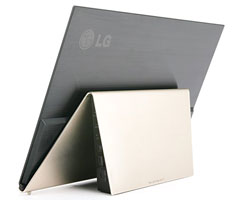Flat-Screens Gone Green
 Televisions rank among the most-used appliances in American homes. In 2008, the U.S. Energy Information Administration estimated that we used 101 billion kilowatt hours of power—7.3% of our total residential electricity usage—watching the tube. Meanwhile, new technologies allow us to watch our favorite shows in big, bright, real-to-life pictures, and many households have a TV in nearly every room.But not all flat-screen televisions are equal, energy-wise. Here’s how to choose the most energy-smart new set—and get the most from your current one.
Televisions rank among the most-used appliances in American homes. In 2008, the U.S. Energy Information Administration estimated that we used 101 billion kilowatt hours of power—7.3% of our total residential electricity usage—watching the tube. Meanwhile, new technologies allow us to watch our favorite shows in big, bright, real-to-life pictures, and many households have a TV in nearly every room.But not all flat-screen televisions are equal, energy-wise. Here’s how to choose the most energy-smart new set—and get the most from your current one.
Knowing the Technology
The amount of power a television uses is influenced by three variables: screen size, technology type and picture brightness, according to CNET.com. In general, a larger screen will consume more power than a smaller screen.

The most prevalent flat-screen technologies are plasma and LCD (liquid crystal display) televisions. In terms of energy efficiency, “LCD really dominates, then plasma and then projection units,” says Katharine Kaplan, Environmental Protection Agency team leader for Energy Star product development. LCDs are also household favorites,―representing 80% of television sales―and many of those sets are in the 40-inch range.LCDs use up to half the power of plasmas, assuming the same brightness level. Some LCD televisions also use LED backlights instead of fluorescent lights, saving even more energy. LED-backlit LCDs are the most efficient type of flat-panel television available today, according to CNET, although the actual savings over a standard LCD usually amounts to less than $20 per year.
Plasma televisions generally use the most power. A 50-inch Sam-sung plasma television, for instance, will use more than 260 kilowatt-hours per year, based on a five-hours-a-day schedule. A comparable-sized Samsung LCD will use about 190 kilowatt-hours per year. But do your homework, and you can find 60-inch LCDs that use under 100 watts.
Another new technology, DLP (digital light processing) can also be energy efficient when it uses LCD light bulbs. But most DLPs come in sizes over 60 inches, and use 200 to a whopping 400 kilowatt-hours per year.
To add to the confusion, some CRT (cathode ray tube) televisions (an older technology) now come in flat-screen versions. Old CRT technology is comparably inefficient, though a small CRT may use less than a giant flat-screen model.
Rear-projection high definition televisions are among the most energy efficient technologies for wider televisions, but are not as common. If you’re in the market for a screen size of 80 inches or more, you’ll find reasonable energy efficiency in a flat-screen projection unit, according to Kaplan. At that size, you can expect to get around 200 watts of energy.
A new technology―called OLED, or organic light emitting diode,―promises to top energy efficiency charts, be the most economical choice and have the best picture quality once it becomes widespread. “People have been waiting for it because it offers the promise of incredible efficiency and a fabulous picture,” says Kaplan. Currently, OLEDs come in screen sizes of 20 inches and less. “It’s a technology to watch,” she says.
Take It Down a Notch
No matter what model of flat-screen you buy or own, you can tweak the settings to save more energy. Many TVs arrive adjusted to the brightest setting to make colors and images pop. This consumes an unnecessary amount of power and isn’t ideal for picture quality.
Adjust the settings to match room lighting, and you’ll slash power use while still getting good picture quality. Some newer flat-screen models may have “energy saver” modes that automatically adjust backlighting.
Flat-screens also consume power in “standby” or “off” mode, when the television is ready to receive a remote control signal. Energy Star (version 4.1 and version 5.1) requires certified devices to consume less than one watt of power in standby mode. Additionally, new Energy Star requirements state that the lowest energy-consuming sleep mode must be the default setting for shipment.
Considering buying a new television? Shop the list of Energy Star-qualified televisions, which all use about 40% less energy than standard units.
CONTACTS: CNET; Energy Star Models.

